The History Of Suzuki Escudo

The Suzuki Escudo (known as Sidekick in North America and Vitara in Europe, the Philippines and Australia, as well as North America after 1999) was a small off-road vehicle produced from 1989-2004. The North American version was produced as a joint venture between Suzuki and General Motors known as CAMI. The vehicle was a follow-up to the popular SJ413 and Samurai. Also, this vehicle, while sold in North America, was designed to slot above the Samurai. A larger version is also made, known as the Suzuki Grand Escudo (known as Grand Vitara XL-7 in other markets).
The Sidekick was sold in various badges such as the Geo Tracker (Chevrolet Tracker after 1998) in the United States, and as the GMC Tracker, Chevrolet Tracker, Asüna Sunrunner and Pontiac Sunrunner in Canada. It was also sold as the Santana 300 and 350 in Spain. In the Japanese home market, it was variously sold also with Mazda badge. The 1st Generation Escudo was sold in Mexico as the Chevrolet Vitara. The 2nd Generation is currently sold in Mexico as the Chevrolet Tracker, as the Chevrolet Grand Vitara in other Central and South American countries, while in Argentina, Uruguay, Paraguay and Chile is sold as the Suzuki Grand Vitara.
The original 1989 North American Sidekick was available as a 2-door convertible or hardtop, in 1.3 liter JA and more powerful 4-wheel-drive JX & JLX trims. An 80hp (60kW) 1.6 liter, 8-valve, 4-cylinder engine was available on the JX & JLX. 1990 brought the deletion of the upscale JLX version. In 1991, a 4-door Sidekick with a lengthened wheelbase was introduced and the following year a 95hp (71kW), 1.6 liter, 16-valve engine was introduced. 1991 also brought the introduction of rear antilock brakes. The original Sidekick was updated in 1996 with a new Sport version available with 120hp (89kW), 1.8 liter 16-valve 4-cylinder engine. The Sport also had dual airbags, 2-tone paint and 16" Alloy wheels.
In 1996, Suzuki introduced the Suzuki X-90 which was mechanically identical to the Sidekick but had a much rounder body, a trunk, and removable T-bar roof. The Suzuki X-90 disappeared from Suzuki's lineup after the 1998 model year. The Sport variant was replaced by the Grand Vitara in 1999.
In Spain, production went on at Suzuki's partner Santana with the Vitara nameplate. After a facelift in 2005 the name was changed to Santana 300/ 350.
In Australia, there were two models available. The Vitara JX and the Vitara JLX. The JLX featured mainly with powered windows. Both versions featured the 1.6 Litre engine. In May 1997, Suzuki introduced the 1995 cc 2.0 Litre 4 Valves/ Cylinder Double Overhead Cam engine with both soft top and hardtop 3 door models. This engine was rated at 97kW (130hp) @ 6300 rpm. At the same time the 5 door models received the 1998 cc 2.0 litre V6. Engine power rated for the 5 door V6 models was at 100kW (134hp) @ 6500 rpm. The 1.6 litre variant for the 3 door models were named the Suzuki Vitara Rebel. All models in Australia were sold as four wheel drives.
The naming scheme, engines and trim options available in Chile, closely follow that of the Australian market. In 1998, there became available models featuring 1.9 litre turbodiesel engines from Renault, built in Spain by Santana Motors, all of them were 4WD vehicles, but there were no automatic transmissions available. Since 2001, all diesel 1st Gen Vitaras are to be imported from Argentina, built by General Motors in Argentina, featuring 1.9 litre HDI engines from PSA, all of them with 5-speed mechanic transmissions, while automatic transmissions are only available with Japanese built models with gasoline engines.
The Escudo/ Vitara was redesigned in 1999, and the Sidekick name was dropped in North America, using the Vitara name instead. It was a 4-seater which in Europe featured 1.3L, 1.6L and 1.8L straight-4 gasoline engines available with carburator or electronic fuel injection. 16 valve engines 1.8 liters and a 2.0 liter V6. Diesel engines were also available in Europe. The Vitara was available with 4- and 5-speed manual transmissions, as well as automatic transmission, and in hardtop 2- or 4-door models or soft-top 2-door models:
In America, the regular Vitara (not grand vitara) was available with a 1.6 and 2.0 four cylinder, with the vast majority of 1.6 liter motors being found in the two door variants and the 2.0 in the four door versions. A 2.5 liter v6 was also available, which became standard in 2004. All were available with manual transmissions or four wheel drive, via a manual transfer case. Vitara was not discontinued in 2003; production continued in the existing body style until 2005 in the existing body style and continues in an updated body style to the present under the Grand Vitara name. The Vitara was the last compact SUV sold in the US to retain a body on frame construction until 2006 when Suzuki phased it out for the newer unibody Grand Vitara.
The four Chevy tracker shared the platform with the vitara from 1999-2004 and though the two are cosmetically nearly identical, there are many differences in the wiring, color combinations, wheels and tires, switchgear, and other technical details. The two door trackers also shared the two door vitara body style for some years.
Suzuki used a specially built spaceframe racing car for hillclimb races with a bodyshell to resemble the Escudo. This race car was specially tuned with 987 bhp and four wheel drive, sporting huge aerodynamic aids. It was entered by Suzuki in a number of Japanese events in the late-1990s, where it beat most of the competition.
The car regularly takes part in the Pikes Peak International Hillclimb, driven by Nobuhiro "Monster" Tajima and is identifiable by its large rear wing and red paintjob. The car is referred to as the Pikes Peak Edition in the Gran Turismo videogames, although that name has never been used by Suzuki.
From Wikipedia, the free encyclopedia
More About Suzuki Escudo
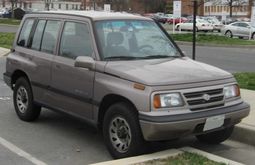
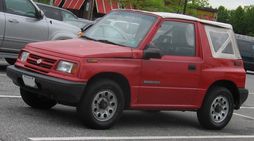
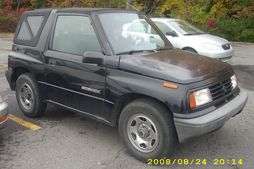
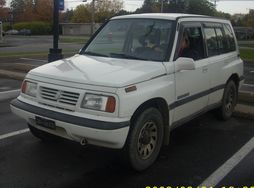
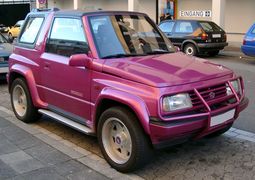
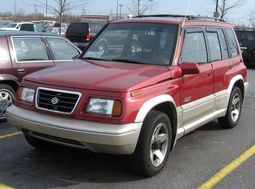
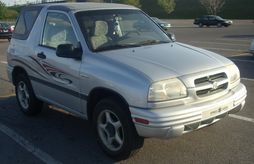
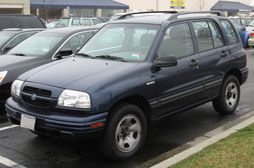
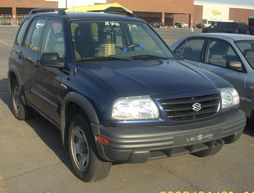
|